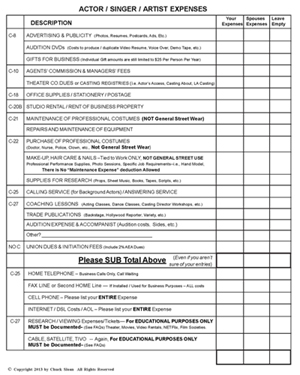
The more notes and records you can keep
the better off you are going to be in protecting
your investment in yourself.
The IRS loves multiple layers of proof when it comes to proving what expenses you incurred and thus what you can deduct off of your tax bill. As far as that goes, we love it too.
For example, you have a business lunch. Keep the receipt. AND write on the top of the receipt the name of the person you lunched-drank-coffeed-dined with AND what their business relationship is to you (writing partner, agent, tax preparer), AND what the purpose/slash/topic of conversation was, i.e. WHY you paid for their lunch-drinks-coffee-dinner.
Did you pay with a debit card? Great, also write an abbreviated version of this in your checkbook register or bank statement.
Did you pay with a credit card? Great, highlight this charge on your monthly bill.
Did you pay with cash? Then you had better be very clear with your notes written at the top of the receipt. AND hopefully you keep a calendar (either hand written in book form or electronic in your computer), and you’ve made reference to this business lunch there too. So with this example, you have:
A. a receipt.
B. a checkbook register/credit card statement.
C. a calendar entry.
D. a mileage log entry.
Ahh, Beautiful Redundancy.
The official IRS term for all of this writing is called “Contemporaneous notes.” They love it. We’ll get into how effective this is a little later.
Let’s move on to a different area that requires note taking: Your aforementioned Mileage Log.
“What’s a Mileage Log?”, you ask. On this page below is a link where you can download “Jordana’s Mileage Log”. Sure, you can buy one from any office supply store and yes, that’s a deduction in both cost AND mileage but it isn’t quite the same as the (exclusive to Chuck Sloan & Associates), “Jordana’s Mileage Log”.
In 2016 if you use the standard mileage expense, Business Mileage is worth 54 cents per mile every time you drive to AND FROM an audition, acting, voice or dance class, office supply store, rehearsal (when you are not getting paid), union function, educational viewing of a film or play, business lunch-coffee-drinks, meet with an agent or manager, headshot session, photo retouching, photo printing and so much more. The list of “Job Search” or Business Mile activities is quite long and quite valuable to you.
If you have a newer car and you are using a percentage of your actual expenses then you need to keep every receipt that pertains to your car from gasoline purchases to car washes to deodorizers. But you still need to keep track of your mileage, because the percentage of actual expenses that you can deduct is the business mileage percentage of your total miles.
In the spirit of redundancy, you should keep oil change receipts and tire rotation receipts; in short, every dated repair receipt that shows your odometer reading when you came into an automotive facility. Not only do these receipts provide proof of your expenses, they validate the overall mileage for the year from which your business mileage percentage is determined, hence your overall deduction is created.
Or let’s consider you take an acting class but the coach likes to get paid in cash. If the amount you pay each week is written down in your calendar or date book, that’s a valid receipt. Again, you need to put down:
1. the date,
2. the amount,
3. who it was paid to and
4. the purpose of the expense to make it valid.
Of course you are keeping track of this mileage in your mileage log as well. In this case the receipt backs up the mileage log which is backed up by the calendar and is backed up by the receipt. It comes full circle - let’s see the IRS deny that expense!
It is especially valuable if it is “contemporaneously” written, (defined as “originating during the same time”). These notes are golden. They love the dirt, the smudged ink, the food/coffee stains; the overall "reality" of the pages.
Before an audit many taxpayers want to copy the records into new notebooks to make the documentation more readable for an examiner. They are always surprised when we tell them not to touch the evidence. It just doesn’t get any better than letting the examiner see the records in their original form, even if they are more difficult to read..
|


